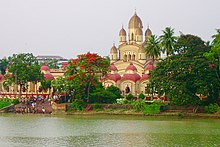 Ramakrishna Paramahamsa
Ramakrishna Paramahamsa
----------------------------------------------------------------------------
 Bengal (/bɛŋˈɡɔːl/;[3] Bengali: বাংলা/বঙ্গ, lit. 'Bānglā/Bôngô' [bɔŋgo]) is a geopolitical, cultural and historical region in Asia, which is located in the eastern part of the Indian subcontinent at the apex of the Bay of Bengal. Geographically, it is made up by the Ganges-Brahmaputra delta system, the largest such formation in the world; along with mountains in its north bordering the Himalayan states of Nepal and Bhutanand east bordering Burma.
Bengal (/bɛŋˈɡɔːl/;[3] Bengali: বাংলা/বঙ্গ, lit. 'Bānglā/Bôngô' [bɔŋgo]) is a geopolitical, cultural and historical region in Asia, which is located in the eastern part of the Indian subcontinent at the apex of the Bay of Bengal. Geographically, it is made up by the Ganges-Brahmaputra delta system, the largest such formation in the world; along with mountains in its north bordering the Himalayan states of Nepal and Bhutanand east bordering Burma.
Politically, Bengal is divided between the sovereign Republic of Bangladesh, which covers two thirds of the region, and West Bengal which is now part of India. In 2011, the population of Bengal was estimated to be 250 million,[4] making it one of the most densely populated regions in the world.[5] An estimated 160 million people live in Bangladesh, while 91.3 million people live in West Bengal. The predominant ethno-linguistic group is the Bengali people, who speak the Indo-Aryan Bengali language. Bengali Muslims are the majority in Bangladesh. Bengali Hindus are the majority in West Bengal. Outside Bengal proper, the Indian territories of Assam, Jharkhand, Bihar and the Andaman and Nicobar Islands, are also home to significant communities with Bengali heritage.[6]
Dense woodlands, including hilly rainforests, cover Bengal's northern and eastern areas; while an elevated forested plateau covers its central area. In the littoral southwest are the Sundarbans, the world's largest mangrove forest and home of the Bengal tiger. In the coastal southeast lies Cox's Bazaar, the longest beach in the world[vague], at 125 km (78 mi).[7] The region has a monsoon climate, which the Bengali calendar divides into six seasons.
Bengal has played a major role in history. At times an independent regional empire, the historical region was a leading power in Southeast Asia and later the Islamic East, with extensive trade networks. In antiquity, its kingdoms were known as seafaring nations. Bengal was known to the Greeks as Gangaridai, notable for mighty military power. According to Greek historians Megasthenes and Arrian, Alexander the Great withdrew from South Asia anticipating a counterattack from an alliance of Gangaridai.[8] Later writers noted merchant shipping links between Bengal and Roman Egypt.
The Bengali Pala Empire was the last major Buddhist imperial power in the subcontinent,[9] founded in 750 and becoming the dominant power in the northern Indian subcontinent by the 9th century,[10][11]before being replaced by the Hindu Sena dynasty in the 12th century.[9] Islam was introduced during the Pala Empire, through trade with the Abbasid Caliphate.[12] The Islamic Bengal Sultanate, founded in 1352, was absorbed into the Mughal Empire in 1576. The Mughal Bengal Subah province became a major global exporter,[13][14][15] a center of worldwide industries such as muslin, silk, pearl,[16] cottontextiles,[17] and shipbuilding.[18] It was conquered by the British East India Company in 1757 and became the Bengal Presidency, which experienced deindustrialization and famines under British rule.[19] Upon independence, the partition of Bengal (1947) split the region into West Bengal in India and East Pakistan, the latter becoming the independent nation of Bangladesh in 1971.
Bengali culture has been particularly influential in the fields of philosophy, literature, music, shipbuilding, art, architecture, sports, currency, commerce, politics and cuisine.
No comments:
Post a Comment